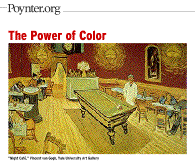
<- Intro to Visual Communication
home DOWNLOAD:
Assignment 8: Color self-portrait
Color is an extremely powerful element in visual communication. I sometimes call it a trump card because its effect can overpower every other element—size, position, similarity, etc.
Try this interactive experiment in color developed by the Poynter Institute:
You'll see how color affects the mood and emotion of a piece of art, and learn more about why it does this.
Perhaps more than any other visual element, color has meanings that may vary considerably from culture to culture. The color of mourning (death) for example, is black in the United States. You might use black to express a solemn, somber mood. Here are simple associations we typically make with colors, as reported by Microsoft.
If you're communicating with a worldwide audience, however, as you may do on the Internet, your meaning may not be as clear as you think.
In South Africa, the color of mourning is red. In Iran, it's blue. In Thailand, a widow wears purple to mourn her husband's death, while in China and Japan, mourning is shown by the color white.
In the contested 2004 election in Ukraine, losing candidate Yushchenko succeeded in creating an identity with the "Orange Revolution." Here's a look at the Orange Revolution in the streets. More recently (2009) the opposition in Iran used green banners to identify their movement. A New York Times article suggested that revolutions need to choose bold colors, and have in throughout history.
How orange stirs both positive and negative emotions is described in Saturday in the park with orange, moving from Christo and Jeanne-Claude's The Gates in Central Park to the Ukraine, ending with Boston's Orange Line.
FactMonster.com has lots more on what colors mean around the world. Another article focuses on how color affects people in the U.S.
Try to beat my score on this Psychology of Color quiz (I got 80%).
Quick! What brand of insulation is pink? What soft drink has a red label? What computer company is called Big Blue? What shipping company talks about the Power of Brown? What colors are the logo of its competition FedEx? What brand of film comes in an orange box? Which in green?
Answers:
You probably were able to answer most of these questions pretty easily. Corporations spend millions (maybe billions) marketing their brand identities, and color plays a huge role in it. There is a trademarked Coca-Cola red and Owens-Corning pink. As you might imagine, there are sometimes legal disputes over who "owns" the right to use a particular color. Read more about them in the Color Matters article Who Owns Hues?
A more positive twist on this is The Power of Pink, a newspaper article that describes how the pink color identified with Breast Cancer Awareness Month (October) has been adopted by everything from M&Ms to Keds sneakers and KitchenAid appliances as a marketing/fund raising strategy. It all started with pink ribbon lapel pins. Not everyone is enthused by the success of this campaign, calling it pinkwashing. Wikipedia has an interesting article on the pink ribbon that explains the criticism of it. This type of low commitment, feel-good involvement in an issue has been labeled slacktivism.
Think about the various colors of lapel ribbons you've seen. What does a red ribbon signify? A yellow one?
 More recent offshoots are the magnetic
"ribbons" that people put on their cars, and of course colored wristbands
like Lance Armstrong's "Live Strong." What next? How about the combo shown
at right? Click on the photo to find out what it represents.
More recent offshoots are the magnetic
"ribbons" that people put on their cars, and of course colored wristbands
like Lance Armstrong's "Live Strong." What next? How about the combo shown
at right? Click on the photo to find out what it represents.
Every semester I ask students to create an abstract self-portrait that expresses who they are.
Take a look at these samples of student work from previous semesters. Do you think you can tell which ones are male and which are female? Who is outgoing and who is shy?
For more ideas, download this article on choosing colors from Before & After magazine.
OTHER WEEKS:
WK1
| WK2 | WK3
| WK4 | WK5
| WK6 | WK7
| WK8 | WK9 | WK10
| WK11 | WK12
| WK13 | WK14
| WK15 | WK16
Visit Al's website, Interactive Design Forum | Send Al email